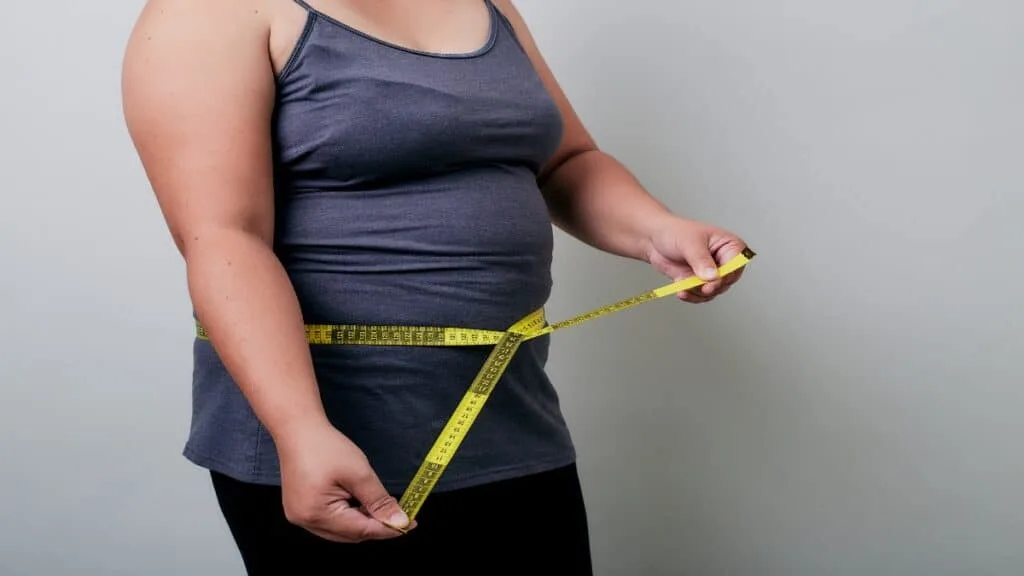A BMI of 32 is considered obese for a man and a woman. Specifically, a 32 BMI score is categorized as class 1 obesity or low-risk obesity.
At this point, a BMI 32 individual still has hope of achieving a healthy body weight in the near future. However, if they gain even more body mass, then their weight loss journey may turn into an uphill battle.
Related:
Is a BMI of 32 obese for a woman?

A BMI of 32 is very much obese for a woman because such a body mass is a sign that a female is carrying excess fat tissue and, therefore, might be at risk for certain chronic diseases if she doesn’t lose weight.
Although a 32 BMI score is technically considered low-risk as far as obesity goes (many people have a BMI that greatly exceeds 32), it’s still a problem because gaining any more fat could prove detrimental.
Although body mass index isn’t always useful when it comes to measuring body fat, it’s more accurate with individuals who have very high or very low BMIs. [1]
This is because if you have a very high BMI, for example, then you almost certainly have too much fat.
On the other hand, if your BMI is normal, then you might just have a healthy amount of muscle mass, but you could also have very little muscle mass and comparatively more fat.
Obviously, despite being “normal,” the latter kind of body composition is unhealthy.
Is a 32 BMI bad for a man?

A BMI of 32 is bad for males because a 32 BMI is considered obese for men. Indeed, a body mass index of 32 is two full BMI points into the obese category, meaning that it’s categorized as class one obesity.
Obviously, since body mass index isn’t great at distinguishing between fat tissue and muscle mass, it’s possible to have a high BMI (i.e., a BMI outside of the normal range) while still being lean.
However, virtually nobody besides professional bodybuilders has a lean BMI of 32. And even if you did, I’m not sure that you could be optimally healthy while being that heavy.
While a man with a 32 BMI score can certainly have a muscular body, it’s not the muscle mass alone that’s giving him such a high BMI. If he lost a lot of his fat, then the man would significantly reduce his BMI as well.
What does a person with a BMI of 32 look like?

Generally, a person with a BMI of 32 looks obese with excess body fat around their waist, legs, and hips.
Of course, since BMI doesn’t directly measure body composition, we can’t say for certain that a BMI 32 person looks like this or that.
Some BMI 32 individuals might have considerably more muscle mass than others.
Additionally, people can have very different fat storage distributions, which can greatly affect how their body looks.
As an example, men tend to store more fat around their waists than women, whereas women usually hold more fat around their hips and thighs.
BMI 32 classifications

It can be useful to know what having a specific BMI means for your body. But without knowing your exact body composition, it’s not possible to say for certain what a given 32 BMI score will look like.
32.1 BMI
A 32.1 BMI is classified as obese, meaning that men and women who have a BMI of 32.1 should lose weight by doing more exercise and eating in a caloric deficit.
32.2 BMI
If you have a BMI of 32.2, then you’re heavier than the average man and woman (who are already overweight) by a few BMI points. As such, weight loss will be necessary for improving your physical health.
32.3 BMI
A BMI of 32.3 is comfortably in the obese category (class 1 obesity). While a person with a 32.3 BMI is unlikely to be at an extreme risk of disease, they might have an elevated risk if they’re carrying minimal muscle mass but storing lots of body fat.
32.4 BMI
A 32.4 BMI is excessive for both males and females and is a strong sign that a person is putting their health at risk by having so much excess body fat.
32.5 BMI
If you have a BMI of 32.5, then you’re considered obese and should seek healthy and sustainable weight loss under the supervision of a doctor. A 32.5 BMI, although high, is still classed as low-risk obesity rather than moderate or high-risk.
32.6 BMI
A BMI of 32.6 is a high body mass index score that needs attention. Of course, given that obesity is a growing problem, it’s likely that many people have a BMI that exceeds 32.6. [2]
32.7 BMI
Those with a 32.7 BMI are well into the obese body mass index category and will need to lose body fat in order to gain control of their health. You can do this by eating in a calorie deficit, performing cardiovascular exercise, and doing strength training.
32.8 BMI
If you’ve got a BMI of 32.8, then while you might have some muscle mass, it’s likely that you’re carrying far more fat tissue than lean mass.
32.9 BMI
A BMI of 32.9 is a few BMI points higher than average for American males and females and should be addressed before the individual gains any more weight and puts themself at serious risk of disease.
The verdict on having a 32 BMI
Although a BMI of 32 is undeniably high for both females and males, it’s not that much higher than average for Americans.
Still, considering that obesity is a very serious problem, people who register a 32 BMI score should try to lose weight and improve their body composition.
While many people can lose weight over the short term, the best path to a healthier body weight is via sustainable weight loss.
After all, if you crash diet or do too much exercise straight away, then you’ll hit a weight loss plateau sooner because your body won’t have anywhere to go, so to speak, given that your calories are already so low.
Instead, employ moderate calorie restriction (500 to 800 per day is a good starting point) and exercise a few times per week and, ideally, daily if you can.
References
- Romero-Corral, A., Somers, V. K., Sierra-Johnson, J., Thomas, R. J., Collazo-Clavell, M. L., Korinek, J., Allison, T. G., Batsis, J. A., Sert-Kuniyoshi, F. H., & Lopez-Jimenez, F. (2008). Accuracy of body mass index in diagnosing obesity in the adult general population. International journal of obesity (2005), 32(6), 959–966. https://doi.org/10.1038/ijo.2008.11
- Flegal, K. M., Carroll, M. D., Kuczmarski, R. J., & Johnson, C. L. (1998). Overweight and obesity in the United States: prevalence and trends, 1960-1994. International journal of obesity and related metabolic disorders : journal of the International Association for the Study of Obesity, 22(1), 39–47. https://doi.org/10.1038/sj.ijo.0800541

